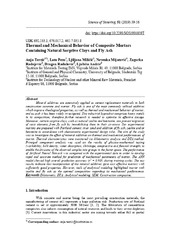Приказ основних података о документу
Thermal and Mechanical Behavior of Composite Mortars Containing Natural Sorptive Clays and Fly Ash
| dc.creator | Terzić, Anja | |
| dc.creator | Pezo, Lato | |
| dc.creator | Miličić, Ljiljana | |
| dc.creator | Mijatović, Nevenka | |
| dc.creator | Radojević, Zagorka | |
| dc.creator | Radulović, Dragan | |
| dc.creator | Andrić, Ljubiša | |
| dc.date.accessioned | 2022-04-18T15:21:14Z | |
| dc.date.available | 2022-04-18T15:21:14Z | |
| dc.date.issued | 2019 | |
| dc.identifier.issn | 0350-820X | |
| dc.identifier.uri | http://rims.institutims.rs/handle/123456789/374 | |
| dc.description.abstract | Mineral additives are extensively applied as cement replacement materials in both construction concrete and mortar. Fly ash is one of the most commonly utilized additives which improve Theological properties, as well as thermal and mechanical behavior of mortar, and as such it has been widely investigated. This industrial byproduct comprises heavy metals in its composition; therefore further research is needed to optimize its effective dosage. Moreover, certain sorptive clays, such as natural zeolite and bentonite, can prevent migration of toxic elements from fly ash by immobilizing them in their structure. Ten experimental mortars are prepared with Portland cement, river sand and addition of fly ash, zeolite and/or bentonite in accordance with chemometric experimental design rules. The aim of the study was to investigate the effect of mineral additives on thermal and mechanical performances of mortar. Thermal characteristics were monitored via dilatometric analysis and DTA method. Principal component analysis was used on the results of physico-mechanical testing (workability, bulk density, water absorption, shrinkage, compressive and flexural strength) to enable the divisions of the observed samples into groups in the factor space. The performance of Artificial Neural Network was compared with the experimental data in order to develop rapid and accurate method for prediction of mechanical parameters of mortar. The ANN model showed high overall prediction accuracy (r(2) = 0.989, during training cycle). The test results indicate that incorporation of the mineral additives gave cost effective mortars with sufficiently good properties. However, tools of analytical modeling highlighted mortar with zeolite and fly ash as the optimal composition regarding its mechanical performance. | en |
| dc.publisher | Međunarodni Institut za nauku o sinterovanju, Beograd | |
| dc.relation | info:eu-repo/grantAgreement/MESTD/Integrated and Interdisciplinary Research (IIR or III)/45008/RS// | |
| dc.relation | info:eu-repo/grantAgreement/MESTD/Basic Research (BR or ON)/172057/RS// | |
| dc.rights | openAccess | |
| dc.rights.uri | https://creativecommons.org/licenses/by/4.0/ | |
| dc.source | Science of Sintering | |
| dc.subject | SEM | en |
| dc.subject | DTA | en |
| dc.subject | Dilatometry | en |
| dc.subject | Construction composites | en |
| dc.subject | Analytical modeling | en |
| dc.title | Thermal and Mechanical Behavior of Composite Mortars Containing Natural Sorptive Clays and Fly Ash | en |
| dc.type | article | |
| dc.rights.license | BY | |
| dc.citation.epage | 56 | |
| dc.citation.issue | 1 | |
| dc.citation.other | 51(1): 39-56 | |
| dc.citation.rank | M22 | |
| dc.citation.spage | 39 | |
| dc.citation.volume | 51 | |
| dc.identifier.doi | 10.2298/SOS1901039T | |
| dc.identifier.fulltext | http://rims.institutims.rs/bitstream/id/229/371.pdf | |
| dc.identifier.scopus | 2-s2.0-85069883425 | |
| dc.identifier.wos | 000496247800004 | |
| dc.type.version | publishedVersion |

